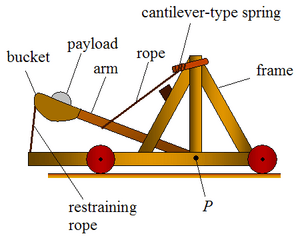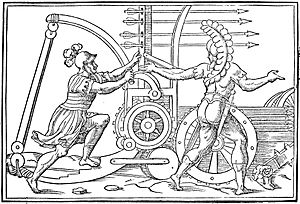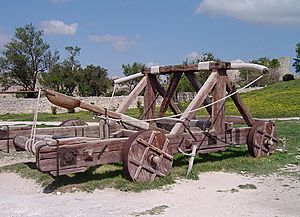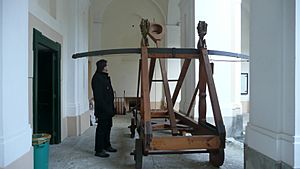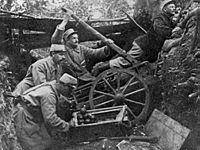Catapult facts for kids
A catapult is a ballistic device used to launch a projectile a great distance without the aid of gunpowder or other propellants – particularly various types of ancient and medieval siege engines. A catapult uses the sudden release of stored potential energy to propel its payload. Most convert tension or torsion energy that was more slowly and manually built up within the device before release, via springs, bows, twisted rope, elastic, or other materials and mechanisms.
In use since ancient times, the catapult has proven to be one of the most persistently effective mechanisms in warfare. In modern times the term can apply to devices ranging from a simple hand-held implement (also called a "slingshot") to a mechanism for launching aircraft from a ship.
The earliest catapults date to at least the 7th century BC, with King Uzziah, of Judah, recorded as equipping the walls of Jerusalem with machines that shot "great stones". Catapults are mentioned in Yajurveda under the name "Jyah" in chapter 30, verse 7. In the 5th century BC the mangonel appeared in ancient China, a type of traction trebuchet and catapult. Early uses were also attributed to Ajatashatru of Magadha in his, 5th century BC, war against the Licchavis. Greek catapults were invented in the early 4th century BC, being attested by Diodorus Siculus as part of the equipment of a Greek army in 399 BC, and subsequently used at the siege of Motya in 397 BC.
Contents
Etymology
The word 'catapult' comes from the Latin 'catapulta', which in turn comes from the Greek Ancient Greek: καταπέλτης (katapeltēs), itself from κατά (kata), "downwards" and πάλλω (pallō), "to toss, to hurl". Catapults were invented by the ancient Greeks and in ancient India where they were used by the Magadhan Emperor Ajatashatru around the early to mid 5th century BC.
Greek and Roman catapults
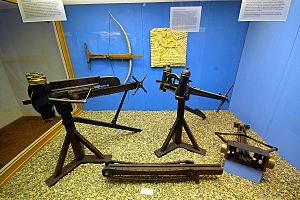
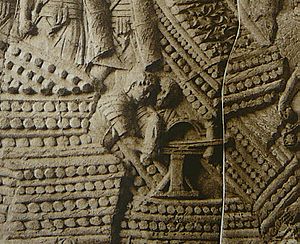
The catapult and crossbow in Greece are closely intertwined. Primitive catapults were essentially "the product of relatively straightforward attempts to increase the range and penetrating power of missiles by strengthening the bow which propelled them". The historian Diodorus Siculus (fl. 1st century BC), described the invention of a mechanical arrow-firing catapult (katapeltikon) by a Greek task force in 399 BC. The weapon was soon after employed against Motya (397 BC), a key Carthaginian stronghold in Sicily. Diodorus is assumed to have drawn his description from the highly rated history of Philistus, a contemporary of the events then. The introduction of crossbows however, can be dated further back: according to the inventor Hero of Alexandria (fl. 1st century AD), who referred to the now lost works of the 3rd-century BC engineer Ctesibius, this weapon was inspired by an earlier foot-held crossbow, called the gastraphetes, which could store more energy than the Greek bows. A detailed description of the gastraphetes, or the "belly-bow", along with a watercolor drawing, is found in Heron's technical treatise Belopoeica.
A third Greek author, Biton (fl. 2nd century BC), whose reliability has been positively reevaluated by recent scholarship, described two advanced forms of the gastraphetes, which he credits to Zopyros, an engineer from southern Italy. Zopyrus has been plausibly equated with a Pythagorean of that name who seems to have flourished in the late 5th century BC. He probably designed his bow-machines on the occasion of the sieges of Cumae and Milet between 421 BC and 401 BC. The bows of these machines already featured a winched pull back system and could apparently throw two missiles at once.
Philo of Byzantium provides probably the most detailed account on the establishment of a theory of belopoietics (belos = "projectile"; poietike = "(art) of making") circa 200 BC. The central principle to this theory was that "all parts of a catapult, including the weight or length of the projectile, were proportional to the size of the torsion springs". This kind of innovation is indicative of the increasing rate at which geometry and physics were being assimilated into military enterprises.
From the mid-4th century BC onwards, evidence of the Greek use of arrow-shooting machines becomes more dense and varied: arrow firing machines (katapaltai) are briefly mentioned by Aeneas Tacticus in his treatise on siegecraft written around 350 BC. An extant inscription from the Athenian arsenal, dated between 338 and 326 BC, lists a number of stored catapults with shooting bolts of varying size and springs of sinews. The later entry is particularly noteworthy as it constitutes the first clear evidence for the switch to torsion catapults, which are more powerful than the more-flexible crossbows and which came to dominate Greek and Roman artillery design thereafter. This move to torsion springs was likely spurred by the engineers of Philip II of Macedonia. Another Athenian inventory from 330 to 329 BC includes catapult bolts with heads and flights. As the use of catapults became more commonplace, so did the training required to operate them. Many Greek children were instructed in catapult usage, as evidenced by a 3rd Century B.C. inscription from the island of Ceos in the Cyclades [regulating] "catapult shooting competitions for the young". Arrow firing machines in action are reported from Philip II's siege of Perinth (Thrace) in 340 BC. At the same time, Greek fortifications began to feature high towers with shuttered windows in the top, which could have been used to house anti-personnel arrow shooters, as in Aigosthena. Projectiles included both arrows and (later) stones that were sometimes lit on fire. Onomarchus of Phocis first used catapults on the battlefield against Philip II of Macedon. Philip's son, Alexander the Great, was the next commander in recorded history to make such use of catapults on the battlefield as well as to use them during sieges.
The Romans started to use catapults as arms for their wars against Syracuse, Macedon, Sparta and Aetolia (3rd and 2nd centuries BC). The Roman machine known as an arcuballista was similar to a large crossbow. Later the Romans used ballista catapults on their warships.
Other ancient catapults
In chronological order:
- 19th century BC, Egypt, walls of the fortress of Buhen appear to contain platforms for siege weapons.
- c.750 BC, Judah, King Uzziah is documented as having overseen the construction of machines to "shoot great stones".
- between 484 and 468 BC, India, Ajatashatru is recorded in Jaina texts as having used catapults in his campaign against the Licchavis.
- between 500 and 300 BC, China, recorded use of mangonels. They were probably used by the Mohists as early as the 4th century BC, descriptions of which can be found in the Mojing (compiled in the 4th century BC). In Chapter 14 of the Mojing, the mangonel is described hurling hollowed out logs filled with burning charcoal at enemy troops. The mangonel was carried westward by the Avars and appeared next in the eastern Mediterranean by the late 6th century AD, where it replaced torsion powered siege engines such as the ballista and onager due to its simpler design and faster rate of fire. The Byzantines adopted the mangonel possibly as early as 587, the Persians in the early 7th century, and the Arabs in the second half of the 7th century. The Franks and Saxons adopted the weapon in the 8th century.
Medieval catapults
Castles and fortified walled cities were common during this period and catapults were used as siege weapons against them. As well as their use in attempts to breach walls, incendiary missiles, or diseased carcasses or garbage could be catapulted over the walls.
Defensive techniques in the Middle Ages progressed to a point that rendered catapults largely ineffective. The Viking siege of Paris (885–6 A.D.) "saw the employment by both sides of virtually every instrument of siege craft known to the classical world, including a variety of catapults", to little effect, resulting in failure.
Modern use
Military
The last large scale military use of catapults was during the trench warfare of World War I. During the early stages of the war, catapults were used to throw hand grenades across no man's land into enemy trenches. They were eventually replaced by small mortars.
In the 1840s the invention of vulcanized rubber allowed the making of small hand-held catapults, either improvised from Y-shaped sticks or manufactured for sale; both were popular with children and teenagers. These devices were also known as slingshots in the USA.
Special variants called aircraft catapults are used to launch planes from land bases and sea carriers when the takeoff runway is too short for a powered takeoff or simply impractical to extend. Ships also use them to launch torpedoes and deploy bombs against submarines. Small catapults, referred to as "traps", are still widely used to launch clay targets into the air in the sport of clay pigeon shooting.
Entertainment
In the 1990s and into the early 2000s, a powerful catapult, a trebuchet, was used by thrill-seekers first on private property and in 2001–2002 at Middlemoor Water Park, Somerset, England, to experience being catapulted through the air for 100 feet (30 m). The practice has been discontinued due to a fatality at the Water Park. There had been an injury when the trebuchet was in use on private property. Injury and death occurred when those two participants failed to land onto the safety net. The operators of the trebuchet were tried, but found not guilty of manslaughter, though the jury noted that the fatality might have been avoided had the operators "imposed stricter safety measures." Human cannonball circus acts use a catapult launch mechanism, rather than gunpowder, and are risky ventures for the human cannonballs.
Early launched roller coasters used a catapult system powered by a diesel engine or a dropped weight to acquire their momentum, such as Shuttle Loop installations between 1977 and 1978. The catapult system for roller coasters has been replaced by flywheels and later linear motors.
Pumpkin chunking is another widely popularized use, in which people compete to see who can launch a pumpkin the farthest by mechanical means (although the world record is held by a pneumatic air cannon).
See also
 In Spanish: Catapulta para niños
In Spanish: Catapulta para niños



